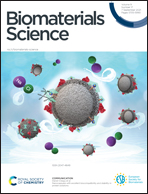The role and mechanism of polydopamine and cuttlefish ink melanin carrying copper ion nanoparticles in antibacterial properties and promoting wound healing†
Abstract
Melanin and its analogue polydopamine (PDA) have attracted considerable attention in biomedical science due to their surface-rich metal binding sites, excellent adhesion and good biocompatibility. Bacterial infections at the wound site and uncontrolled bleeding are associated with a high risk of death, and the prevention of wound infections remains a major challenge. On this basis, the four nanoparticles (NPs) of melanin, PDA, copper ion-loaded melanin (Cu(II) loaded melanin) and copper ion-loaded PDA (Cu(II) loaded PDA) were studied in terms of antibacterial and wound healing capabilities. The in vitro experiments showed that Cu(II) loaded PDA NPs had good blood compatibility and low cytotoxicity, showing the best antibacterial effect in comparison with other samples. Not only could the slow release of copper ions from the nanoparticles kill bacteria, but also the phenolic hydroxyl group and amine groups of PDA NPs played a synergistic role in bacterial death. In wound healing experiments, the Cu(II) loaded PDA NPs could easily and tightly bind with biological tissue, demonstrating excellent hemostasis, antibacterial and wound healing capabilities. In summary, the excellent properties of Cu(II) loaded PDA NPs made them a safe and effective drug for preventing wound infection and promoting healing.



 Please wait while we load your content...
Please wait while we load your content...